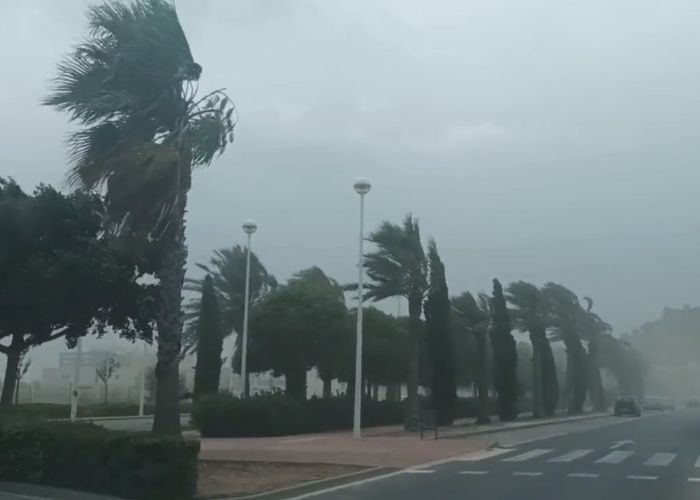ORIHUELA – The weather phenomenon ‘reventón caliente’ for which the province of Alicante was already warned on Saturday by the Spanish weather service has caused a sudden temperature increase to 40 degrees at three in the morning on the Costa Blanca South.
Loosely translated, it is a ‘hot blowout’. It is an atmospheric phenomenon that causes a sudden rise in temperature and strong wind gusts. In various parts of the province, these had a speed of more than 100 kilometres per hour. They caused a lot of damage, especially in the Veja Baja, the extreme south of the province of Alicante. The phenomenon already caused a tragedy in the night from Friday to Saturday with one dead and dozens injured at the Medusa festival in Cullera (Valencia) when the wind gusts flew around parts of the stage and the entrance.
No final figures have been released yet, but so far there have been no more personal accidents. The wind gusts have uprooted trees, blown down antennas and torn canopies, pergolas and road signs.
Atmospherically a historic summer
“This summer is atmospherically historic,” said Jorge Olcina, director of the University of Alicante’s Climatic Observatory. The latest record is the 40ºC that the thermometers reached at three o’clock last night in several neighbourhoods of the capital Alicante. “That temperature has never been reached before sunrise in Alicante,” emphasises the meteorologist. “We are experiencing an exceptional summer with many atmospheric phenomena associated with high temperatures reaching record highs in many cities in the province and region of Valencia,” Olcina added.
Son las 2:40 h y en algunos barrios del sur de Alicante superamos los 40 °C en estos momentos debido a los reventones cálidos que se están produciendo en nuestras comarcas.
En Elche o Torrevieja las rachas de viento han superado los 100 km/h pic.twitter.com/AEpRVuVI5B
— Climatología UA (@climatologia_ua) August 13, 2022
Incidents
The firefighters of the Provincial Consortium worked tirelessly in the early morning hours and had to turn out more than 80 times. A lot of damage has been reported to garden or street furniture. The most affected areas are Santa Pola, Elche and Orihuela.
What is a ‘reventón caliente’ or ‘reventón térmica’?
Despite being a more common atmospheric phenomenon in summer, last morning’s hot eruptions were much more intense than usual. Apart from the sudden temperature rise, they caused sudden gusts of wind with a lot of damage as a result. The Climatic Observatory of the University of Alicante explains it as follows in the newspaper Las Provincias:
“The warm gust forms with high-base or decaying storms. Precipitation then falls through a layer of dry air and evaporates. This makes the descending air cooler and heavier than the surrounding air. As this air cools, it becomes denser and descends at greater speed toward the Earth’s surface. In turn, all the precipitation within that descending air evaporates, making that air completely dry.”
“Because of the momentum that air has already acquired, it is heated by atmospheric compression. It increases as the air descends further. Once that air reaches ground level, the momentum already carried moves horizontally in all directions, resulting in a very strong wind.” In addition, the presence of a very warm and dry air mass, causes the surface temperature to rise very quickly, while the dew point and humidity plummet,” the experts said.


